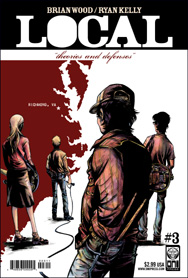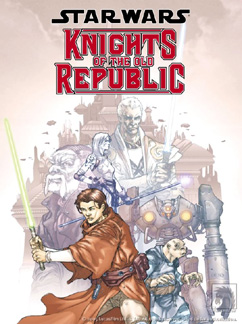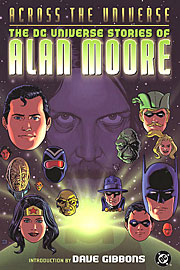Think You Have What It Takes to Be a Warrior-Scribe? Well, Cry Havoc and Let Slip Those Reviews!
 It’s on. The Second “Thor’s Comic Column” Write-on begins…now! So head over to the message boards RIGHT HERE for the brass tacks, and let’s see what you’ve got.
It’s on. The Second “Thor’s Comic Column” Write-on begins…now! So head over to the message boards RIGHT HERE for the brass tacks, and let’s see what you’ve got.
Good luck!
Nextwave: Warren Ellis proves his worth (again)
By Graig
 It’s official, comics are indeed fun again. Whether you like (or can even follow) the events of Infinite Crisis, you have to admit it’s one of the more exciting and adventurous things that has happened in the mainstream in some time, and if that’s not quite your speed, Grant Morrison has offered up one of the highest of conceptual projects that the medium has ever seen in Seven Soldiers. Jonah Hex and Loveless are proving western books viable again, and Conan and Red Sonja are just the start of a whole new era in sword and sorcery. Then we have the bwa ha ha crew of Keith Giffen and JM DeMattis returning the funny back to funny books with stints on JLA Classified, the Defenders and Hero Squared, not to forget Dan Slott’s take on Great Lakes Avengers or She Hulk, Peter David’s return to X-Factor, and Peter Milligan’s resurrection of X-Statix.
It’s official, comics are indeed fun again. Whether you like (or can even follow) the events of Infinite Crisis, you have to admit it’s one of the more exciting and adventurous things that has happened in the mainstream in some time, and if that’s not quite your speed, Grant Morrison has offered up one of the highest of conceptual projects that the medium has ever seen in Seven Soldiers. Jonah Hex and Loveless are proving western books viable again, and Conan and Red Sonja are just the start of a whole new era in sword and sorcery. Then we have the bwa ha ha crew of Keith Giffen and JM DeMattis returning the funny back to funny books with stints on JLA Classified, the Defenders and Hero Squared, not to forget Dan Slott’s take on Great Lakes Avengers or She Hulk, Peter David’s return to X-Factor, and Peter Milligan’s resurrection of X-Statix.
Yes, the grim-and-gritty era is finally over, comics are free (no, you still have to buy them), and in a free comics market we get stuff like Warren Ellis’ Nextwave #1, which in metaphorical terms, is like Russia after the fall of communism. The people are still the same, but the environment is totally different. Suddenly free, anything goes.
Ellis has plugged into Nextwave a rag-tag ensemble of reject Marvel characters representing various trends past, including the grim’n’gritty Captain ****, the bad girl Ellie Bloodstone, the satire of beloved characters represented Dirk Anger and his organization H.A.T.E, the obligatory mutant (whom I think was “Boom Boom” at one point), and the ex-big-time superhero cliché the former Photon, nee Captain Marvel. Ellis also fills the book with superhero deconstructionist dialogue, and uses some winking-eye narrative, which, once wrapped into a tight little burrito and grilled for a minute, makes for one definitely delicious read. Plus, I mean, Fin Fan Foom. Come on!
Ellis has always had a gift for the sardonic, but here he manages to pare back on most of the snark and dole out a light-hearted, comedic, and high-impact romp. It’s as if he took his Global Frequency and filtered it through puritan Lee and Ditko Spider-man. It’s not quite safe for all audiences (the phrase “Mommy was a slut lizard” pops up) but it’s pretty much as close as you’re going to get Ellis to classic superheroics without compromising himself. He touches on expected themes, like corporate greed and his general disdain for superhero conventions, but he does so in a very amusing manner.
Stuart Immonen handles the pencils with every bit of verve that we’d expect of him, although freeing up his layouts to be a bit more playful and allowing for fun panel breaks and eccentric visual angles, and also to visually accentuate Ellis’ fun narrative snips. With Wade von Grawbadger uses a bit more of an angular line when inking than I’m used to seeing in Immonen’s art, but it works for the dynamics of the book and is an unexpected fit. Plus, the always fantastic Dave McCaig is on colors, so it’s a very well rounded and highly talented team, and a solidly entertaining package. 12 issues of Nextwave is going to make for a fun year.
FOUR AND A HALF OUT OF FIVE VIKINGS
Wood and Kelly Make the Universal “Local”
By Russell Paulette
 For most of us, the conceit Brian Wood and Ryan Kelly use for Local is just that—each story is set in a different American city and, as such, is a nice hook upon which you can hang quiet, small dramas. When that conceit—pardon—hits home for you, it can make the work feel quite different. As is the case with the third issue of the series, “theories and defenses,” which is, by far, my favorite, though not just because it’s set where I lay my own head.
For most of us, the conceit Brian Wood and Ryan Kelly use for Local is just that—each story is set in a different American city and, as such, is a nice hook upon which you can hang quiet, small dramas. When that conceit—pardon—hits home for you, it can make the work feel quite different. As is the case with the third issue of the series, “theories and defenses,” which is, by far, my favorite, though not just because it’s set where I lay my own head.
Wood’s story revolves around a successful mid-level band and their return to their hometown of
First, there is Frank, the lead singer and guitarist, speaking on the phone with a journalist about the breakup of the band. Here, he waxes philosophical about music, meaning, and the rigors of the road. Wood cleverly overlaps this conversation onto the other scenes, allowing for some interesting juxtapositions, while also giving it all a sense of cohesion. Next, we meet Bridget, bassist and vocalist, who, it turns out, wrote most of the memorable songs for the band. She’s in make-up/break-up mode with a reliable fling, and her return home signals a change in their relationship. Kevin, the drummer, is trying to get quick cash from the local record shop for his vinyl copies of the band’s albums, and it’s here that the series’ ubiquitous star, Meggin, makes a brief appearance in a heartbreakingly funny scene. Finally, we meet Ross, the guitarist, who is playing a solo acoustic set at a local vegetarian, hole-in-the-wall bar.
Though that encompasses the extent of the plot, such-as-it-was, Wood employs a deft and at characterizing these people in evocative, simple scenes written with a taught control over his subjects. We don’t need to spend an entire issue with Bridget and her comfort lay to feel the tension in the room, just as we don’t need to have Kevin do more than demand cash from a fan asking for an autograph. These few, simple gestures are enough to call these characters into relief and, though bordering on simplified stereotyping, Wood manages to keep it tight and personable by employing his knack for pacing and dialogue.
Kelly’s artwork improves with every panel, and this issue is no exception, as he manages to conjure blustery, fall days when the air is as bleak and crisp as the leaves it blows with abandon. Much has been made of his stylistic similarity to Paul Pope and, if you ask me, there’s much worse comparisons that could be made. That said, his work does feel Pope-ish, while still retaining a quality that is Kelly’s own—an assurance with the pen and on open white space that, frankly, Pope could do well to take note.
Past the fun of seeing Kelly draw landmarks I regularly haunt, or the references Wood threw in for other River City Residents, this issue worked remarkably well for me in the way that it told a simple story in a simple way that drew a line directly to the emotional core of the thing. Rather than inflating his story with overblown melodrama—“you used to be about the music” clichés—Wood gave us the simple, sad fact of four people who just can’t stand each other anymore. And it worked quite well.
FOUR AND A HALF OUT OF FIVE VIKINGS
Dark Horse Comics Launches the First in a Line of New Star Wars Books With “Knights of the
By Sean Fahey
 If I were to say that the Star Wars prequels were a bit disappointing, I wouldn’t be the first. Nor would I be the first to say that, despite Lucas’ best efforts, the Star Wars franchise is still teaming with life – thanks to quality video games, the “Clone Wars” animated series, and a wealth of exciting comic books by Dark Horse. Partially inspired by the insanely popular X-Box video game of the same name, Knights of the
If I were to say that the Star Wars prequels were a bit disappointing, I wouldn’t be the first. Nor would I be the first to say that, despite Lucas’ best efforts, the Star Wars franchise is still teaming with life – thanks to quality video games, the “Clone Wars” animated series, and a wealth of exciting comic books by Dark Horse. Partially inspired by the insanely popular X-Box video game of the same name, Knights of the
Knights of the
In Knights of the
I love the “Fugitive”-esque high concept for this series. “Jedi on the run” is a great premise, with limitless possibilities. What’s more, I’ve always thought that rogues and exiles make for the most interesting protagonists, and while Zayne Carrick isn’t the most original character, he’s very intriguing. I’m interested in finding out exactly how this inexperienced Jedi can use his underworld connections to outsmart and stay one step ahead of dozens of Jedi Knights. Jackson Miller does a good job laying the groundwork for that angle, as Zayne’s interactions with an independent smuggler hint at a burgeoning (albeit tenuous) relationship between the two, and it’s obvious that Zayne is a scoundrel in the making.
If this inaugural issue is an indication, Knights of the
THREE AND A HALF OUT OF FIVE VIKINGS
![]()

DC Universe: The Stories of Alan Moore
DC Comics
By Graig
 I hadn’t realized until picking up this collection (which is a repackaging of Across the Universe trade but with The Killing Joke added in) that Alan Moore had spent such a limited amount of time in the DC Universe playground. Aside from his Swamp Thing work, collected here is the just barely 300 pages of his time with Batman, Superman and small selection of the rest. What’s evident in this capsule is that
I hadn’t realized until picking up this collection (which is a repackaging of Across the Universe trade but with The Killing Joke added in) that Alan Moore had spent such a limited amount of time in the DC Universe playground. Aside from his Swamp Thing work, collected here is the just barely 300 pages of his time with Batman, Superman and small selection of the rest. What’s evident in this capsule is that
With The Killing Joke and his Clayface short story, Moore doesn’t really get a chance to play with Batman, but he does play in Batman’s realm, and he understands that the world of the Dark Knight, by his very motto (that “Criminals are a superstitious and cowardly lot” one), happens on a psychological level. Batman’s villains aren’t just bad people who took a wrong turn and got wrapped up with the wrong crowd… there’s a reason they go to an asylum when captured. His Clayface story is actually a sweet, if demented love story, while the infamous Joker story (made even better with it’s sweet Brian Bolland art) presented Mr. J for the first time in a different light. Up until The Killing Joke, the Joker had been a clownish figure, just a silly, crazy-acting bad guy. But here,
But these DC Universe Stories of Alan Moore aren’t worth anything without his Superman contributions. The first tale, drawn by Dave Gibbons, is entitled “For The Man Who Has Everything” which was fantastically adapted for the Justice League Unlimited cartoon, in which Wonder Woman and Batman show up at the Fortress of Solitude only to find Superman frozen, a symbiotic plant latched to his chest, and his mind lost in a fantasy of his heart’s desire. As familiar as I was with the cartoon episode, the
But beyond that, in “Whatever Happened To The Man of Tomorrow”, Moore tackles the final story of the pre-Crisis/pre-revamp Superman. In it Moore nails on the head not just Superman, but Clark, Lois, Jimmy, Lana, Lex and the more notorious of Superman’s rogues gallery. But it’s not just the characters that Moore hammers home, but also the whole Silver Age and the Crisis/Watchmen/Dark Knight Returns era of maturity that suddenly the mainstream had discovered. Moore sifts all these elements together into a mind-blowing Superman story to end all Superman stories, and it literally is, and it’s all serviced by Curt Swan (with inks by George Perez and Kurt Schaffenberger) which only makes it that much more classical.
As much as I loved the majority of the book, the Vigilante two-parter falls on the less than extraordinary side of things, and in this day of Law & Order:SVU, domestic disturbance stories like this one fall into stereotypical trappings. There’s also a Superman/Swamp Thing story that, given Moore’s relationship with both characters, falls surprisingly flat, even tedious. But those minor missteps, this collection is just more of the same brilliance from the medium’s most gifted talent.
FOUR AND A HALF OUT OF FIVE VIKINGS
Will You Still Love Me If I Wet the Bed?
Top Shelf
By Russell Paulette
 Liz Prince’s debut graphic novel, Will You Still Love Me If I Wet The Bed? wowed them at last year’s Small Press Expo, winning the Outstanding Debut Ignatz award. It features an hilarious introduction by Jeffrey Brown, drawn as a four-panel gag strip, and receives praise from such indy comics luminaries as Paul Hornschemeier, of Mother Come Home fame, as well as Farel Dalrymple, of Pop Gun War and Marvel’s forthcoming Omega the Unknown. Also, notably, is the Top Shelf Productions logo—as they’re the ones footing the bill and publishing the damn thing. So, with all of this going for the book, why did it not impress me?
Liz Prince’s debut graphic novel, Will You Still Love Me If I Wet The Bed? wowed them at last year’s Small Press Expo, winning the Outstanding Debut Ignatz award. It features an hilarious introduction by Jeffrey Brown, drawn as a four-panel gag strip, and receives praise from such indy comics luminaries as Paul Hornschemeier, of Mother Come Home fame, as well as Farel Dalrymple, of Pop Gun War and Marvel’s forthcoming Omega the Unknown. Also, notably, is the Top Shelf Productions logo—as they’re the ones footing the bill and publishing the damn thing. So, with all of this going for the book, why did it not impress me?
To start with, the book has a lot going for it. Much like the work of Brown, Will You Still Love Me… has that same spirit of open, naked honesty—it comes from that school of autobiographical, confessional independent comics. Write-what-you-know taken as literally as possible. Prince also displays a wonderful, whimsical sense of humor—a spirit that that particular subset of indy comics would do well to capture. Some of the strips in the book are laugh-out-loud funny in the way that they capture the giddiness and just-plain-retardation of falling in, and being in, love.
Which probably brings me to my first point—in that, the book is constructed as a series of (mostly) four-panel strips, each about a page long. Thus, calling it a graphic novel feels a little…ambitious. The strips are fine for what they are, and are expertly paced for their four panels, but they lack a certain cohesion when it comes to the book feeling of a whole piece. They’re merely vignettes—snapshots of the life of this couple—and, while effective in displaying openly and honestly the life of a normal, twentysomething relationship, the lack of any sort of narrative thrust left me cold. That said, her comic timing in the individual strips is where much of her humor lies and, while not all the jokes worked for me—and certainly, some of them were saccharine enough to make teeth ache—I can appreciate the difficulty of attempting the humor in the first place.
My other difficulty with the book lies with the artwork, which has that scratchy, unfinished feel, again, reminiscent of Mssr. Brown. Prince’s storytelling is solid enough to carry the artwork through the seventy-odd pages, but her rendering has a quirky unfinishedness to it that eventually drove me crazy. At first, the quirks were endearing—there’s an uncertain hesitancy to the linework that feeds into the quiet intimacies of the book—but, after awhile, I kept wishing for Prince to show an assured, unblemished penstroke or a spotted black or two. Something, anything, other than the same eye guidelines showing her faces. Her cartooning on the front and back of the book has the kind of quality and assurance to the linework that, frankly, the interior is lacking.
With all the praised heaped on the book, I was predisposed to like it quite a bit. Unfortunately, Ms. Prince’s debut effort didn’t hold me in its spell in the same ways as some of its many advocates. That said, I do think Prince displays a lot of raw talent which, when honed, sharpened and refined, will produce something extraordinary. Until then, the potential is there, and Will You Still Love Me… is a promising start.
THREE OUT OF FIVE VIKINGS
So ends this accounting of valiant warriors and high adventure! Return next week to honor still more comics. Praise Odin.
HAVE A COMIC YOU WANT TO SUBMIT FOR REVIEW? Contact Sean at scfahey@yahoo.com.
To discuss this column and all things Nordic, you may contact Sean at scfahey@yahoo.com , Devon at thedevonsanders@yahoo.com , Dave at dave@chud.com , Russell at inadvertent@mail.com , Rob at poprob@gmail.com and Graig at graig@geekent.com.